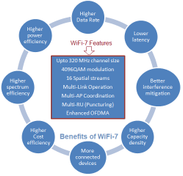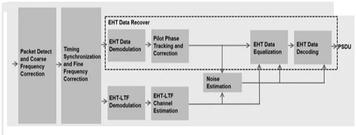WiFi 7 Multi-Link Operation (MLO): Advantages and Use Cases
Advertisement
This page covers WiFi 7 MLO (Multi-Link Operation) features, MLO modes, MLO architecture, and MLO use cases. It mentions the benefits or advantages of MLO used in WiFi 7 as per the IEEE 802.11be standard, as well as the challenges or limitations for MLO implementations.
Introduction
IEEE 802.11be (WiFi-7) is currently under development, and draft specifications 1.0/2.0 are available for developers. The standard is planned to be ratified by 2024. IEEE 802.11be is an amendment to existing IEEE 802.11 PHY/MAC standards.
This WiFi-7 standard is backward compatible with previous WLAN standards and operates in the 2.4 GHz, 5 GHz (Lower and higher), and 6 GHz bands. It offers a maximum throughput of about 30 Gbps with at least one operation mode.
Release-1 features include multi-RU per STA, Multi-Link Operation (MLO), low complexity AP coordination, 320 MHz BW channels, and a 4096 QAM modulation scheme, among others. Release 2 features include 16 x 16 MIMO enhancements, HARQ, low latency operations, and advanced AP coordination, among others.
What is MLO (Multi-Link Operation)?
Multi-Link operation in 802.11be refers to multi-band and multi-channel capabilities. It offers increased data rates, lower latency, and increased reliability. It aggregates multiple frequency channels using different frequency bands simultaneously.

The figure above depicts MLO using three bands: 2.4 GHz, 5 GHz, and 6 GHz between a WiFi AP and STA. It operates in one of three modes: SLO, MLO-STR, and MLO-NSTR.
MLO Case Uses
The typical use cases of 802.11be MLO are as follows:
- Band Steering/Load Balancing: Helps to mitigate congestion on one link.
- Aggregate/Duplicate: Aggregates multiple links to increase data rate and duplicates critical packets on multiple links to withstand against interference.
MLO Modes
Following are the 802.11be WiFi 7 operation modes:
- SLO (Single Link Operation): In this mode, only the primary channel interface is available.
- MLO-STR (Simultaneous Transmission Reception): In this mode, two radio interface links operate independently and asynchronously. Hence, they are capable of transmitting and receiving simultaneously on different links.
- MLO-NSTR (Non-simultaneous Transmission Reception): NSTR is not capable of transmitting/receiving simultaneously on different links. In this mode, one interface functions as primary and the other as secondary. Here, both interfaces are available, but usage of the secondary channel is conditioned on the primary also being unoccupied.
Channel access can be done in one of two ways: asynchronous and synchronous. It re-uses link establishment frames, and no new frames are added in 802.11be. Discovery and setup follow the previous 802.11 standard with some modifications.
Power saving is done similarly to 802.11 TWT agreements. Target Wake Time (TWT) is designed to minimize contention among STAs in order to save power. It uses a new IE (Information Element) in management frames: MLE (Multi-Link Element).
MLO Architecture

MLO architecture is implemented with different partition configurations. One such WiFI-7 MLO device architecture is shown in the figure above. As shown, the MAC sub-layer is divided into Lower MAC (LMAC) and Upper MAC (UMAC).
UMAC is common for all interfaces to perform link operations. LMAC is an individual part for each of the interfaces, which performs link-specific functionalities such as channel access using its unique parameters. The PHY layer will take care of configuring different data rates for various RF bands/channels (2.4 GHz, 5 GHz, and 6 GHz).
Benefits or advantages of MLO in Wi-Fi 7
Following are the benefits or advantages of MLO in Wi-Fi 7:
- It increases the data rate (or throughput) by aggregating multiple links at different bands/channels.
- It improves latency using load balancing which mitigates congestion on one link.
- It increases reliability by duplicating packets on multiple links.
- It allows network traffic to flow seamlessly under interference or congestion scenarios.
- It supports traffic separation/differentiation, which separates different traffic flows to different links.
Challenges of MLO
Some of the challenges of MLO used in WiFI 7 are as follows:
- Wide channels consume more power, which is challenging in mobile device development.
- There is growth in PAPR (Peak to Average Power Ratio) in wider channels.
- There are different interference levels and properties on different subchannels.
Advertisement
 RF
RF


